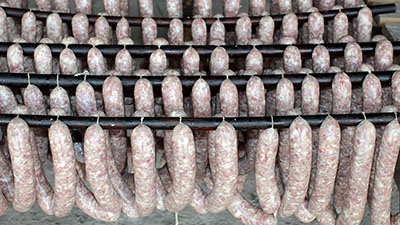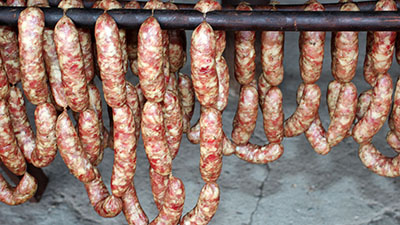Meats and Sausages
Conditioning and Drying Sausages
Drying meats and sausages is mainly affected by:
- Humidity - higher humidity, slower drying
- Temperature - higher temperature, faster drying
- Air flow - faster air speed, faster removal of moisture
Understanding drying is crucial when making slow-fermented, cold-smoked, or air-dried products, as the technology of making these products depends on drying.
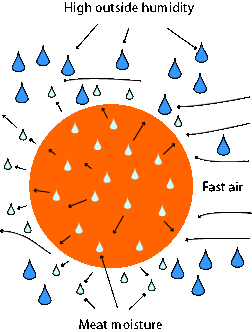
Well-balanced drying. The equilibrium state: diffusion rate = evaporation rate
The sausages are drying from the inside out; the moisture removed from the surface is replaced by the moisture coming from the inside.
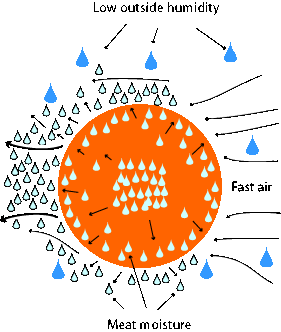
Too fast moisture removal. It is like a faster car pulling away from a slow one. Inside moisture traveling towards the surface can not keep up with the moisture removed from the surface. The sausage becomes dry on the outside and moist inside.
The pronounced effect of fast drying. The surface is dry, with a visible grayish ring on a sliced sausage. If the surface hardening occurs in the first stages of drying, the inside moisture may be permanently trapped, and bacteria will multiply, spoiling the sausage.
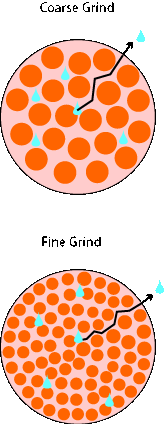
In a course grind meat, the moisture has more free room and a shorter distance to the surface. In a fine grind, the particles are very small, so moisture has to overcome more surface area on its way to the surface. The distance to the surface is longer,This problem is magnified in a large-diameter salami where moisture travels much longer. A large-diameter salami should be dried slower and longer to prevent surface hardening.
More on drying can be found in the Fermented Sausages section.
Conditioning Sausages
Conditioning is a short drying process while manufacturing smoked sausages. This short drying step seems insignificant, but in reality, is very important. Being least understood, it often is neglected. The purpose of conditioning is to:
- Develop a good color in smoked sausage
- Provide additional curing time
Color. A freshly stuffed sausage is moist and should not receive smoke until its casing is dry or at least feels tacky to the touch. Smoke contains thousands of particles, and the larger ones, like soot, will stick to moist sausage instead of leaving the chimney. Such a sausage will be of a dark color and may develop an acidic taste, especially if the smokehouse is moist. Stuffed sausages should hang at room temperature for 1-2 hours; the time, of course, depends on their diameter.
Stuffed moist sausages can be pre-heated inside the smoker, but the smoke should not be present. If natural wood is used for fuel, enough must be burned to obtain sufficient amounts of hot embers that would provide heat without creating smoke. The casings can be dried at 46-54°C (115-130°F) with gas or electricity until dry. Leave draft controls or the top of your smoker fully open. The sausages may be placed in a drafty area; moderate fan use will definitely be of help; however, air-fan drying should not be used for an extended period of time as the surface of smaller sausages may harden. When making a lot of sausages, the first ones are already conditioned and ready for smoking before the last ones are stuffed.
Note: It is extremely important that a smokehouse is dry inside, especially when it is located outside. There could be rainy weather, the separate firebox, the connecting pipe, or the dug-in ground trench can be wet, the walls of the metal smoker can be wet, wood logs, chips, or sawdust can be wet, etc. In such instances, the smokehouse must be heated until it is dry, and only then can the meat be smoked with dry chips.
Curing. Stuffed sausages may contain meat that was not cured or only partially cured. Holding them for 1-2 hours at room temperature provides more time for sodium nitrite to cure the meat

